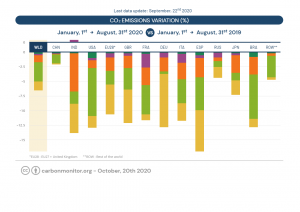Did pandemic lockdowns and the move to online life at least help us cut our climate-killing emissions? From Beijing, new science led by our guest Dr. Zhu Liu provides unexpected answers. Then Canadian scientist Megan Kirchmeier-Young explains extreme rains and floods are popping up all over. But first: can climate change drive humans to extinction? The past speaks to the future with Prof. Pasquale Raia from Italy. Three international guests this week on Radio Ecoshock. The image for this week’s show, called “Fish Wife” is from American painter Kevin Paulsen.
Listen to or download this Radio Ecoshock show in CD Quality (57 MB) or Lo-Fi (14 MB)
PASQUALE RAIA – HOW HUMANS WENT EXTINCT
Could we drive ourselves to extinction by changing the climate? The Extinction Rebellion movement protests our continuing push toward rapid climate change. But is that a real possibility for us? New science finds our earlier cousins, a half dozen other types of humans, WERE driven toward extinction mainly by climate change. We need to know how that works.
Dr. Pasquale Raia has investigated the role of climate in mammals including humans. He is lead author of the new paper “Past Extinctions of Homo Species Coincided with Increased Vulnerability to Climatic Change”. Pasquale is Associate Professor at Università di Napoli Federico II in Italy, and leader at Raia’s Lab

Dr. Pasquale Raia, Naples
For most of the public, talk about human extinction seems unreal, almost a joke. But when science looks back, we find other human types that had tools, fire and a society – disappeared. Now we can legitimately talk about climate change and extinction – at least in the past history of different human species.
I worry the public has too simple a picture of how we humans may go extinct. Our end may come not simply because it is too hot for us to work or be outside, or even due to extreme weather, but perhaps due to extinction of species we depend on, whether in the food chain, or even species we maintain in our guts to digest food.
The standard for what is a “homo” was whether stones were used as tools. It was assumed that began with Homo habilis around 2.1 million years ago, but new research suggests Australopithecus may have used stone tools a million years before that. So even the standards of who and where we began are not settled. This new paper looks at six species of human beings, but there were other minor populations, including one species (H. floresiensis) that was only 1.1 meter (3 ft 7 inches) tall.
CLIMATE AND EXTINCTION
“In summary, we find that all species representing a lineage leaving no offspring had become restricted to unfavorable or otherwise narrowly defined climatic conditions just before their extinction.”
– Raia et al
The most drastic climate changes in the last few million years were the ice ages which buried much of the northern hemisphere in deep glaciers. Based on this work, is global cooling is the major cause of extinction of humans rather than global warming. Earlier types like the Neanderthals, Homo erectus and others developed in hot humid areas and were better adapted to them. Ironically, had they survived, they might be better adapted to the future we homo sapiens are creating now by changing the atmosphere.
I know some listeners have heard of the Toba theory, suggesting humans were reduced to a few thousand individuals due to a volcanic eruption in Indonesia. But recently some scientists discount that (see this paper and this article in the Smithsonian Magazine.)
Perhaps some people believe that we present-day humans just killed off all other competitors like us. But most of the earlier humans existed before we sapiens came along. The Neanderthals did co-exists with us, but research shows we traded with them, and had sexual relations, rather than killing them. All of us have Neanderthal genes. There may have been competition for food, but nothing shows a mass slaughter by present-day humans.
“results confirm that climate change per se played an important role for extinction in past Homo species, consistent with the observation that most species cannot cope with rapid climatic changes.”
– Raia et al.
But now, with our advanced technology, the theory we find of past humans may not apply? Have we gone beyond the rules of the climate limits to survival?Is it possible the warming of the planet will push H. sapiens to evolve, producing a new species better suited for a world that is likely to stay hot and ice-age free for at least 100,000 years? Or we may, with genetic tinkering, create several new species to become?
These scientists find:
“our own future depends critically on the health of Earth’s supporting ecosystems and the entire living biota, and our analysis provides a stark warning concerning the power of anthropogenic future climate change to translate directly into extinction risk for other species less well equipped to adapt than sp. Homo.
This suggests that the threat posed by the current, anthropogenic climate change for global wildlife and, by extension, ourselves, is possibly even more powerful than is generally appreciated.”
================================================================
ZHU LIU: DID THE COVID-19 SHUTDOWN HELP THE CLIMATE?
When the developed world was forced into a temporary shutdown by the COVID-19 pandemic, emissions of climate-shifting greenhouse gases also slowed down. What does that tell us? Is it enough to change our trajectory toward terrible warming and extreme weather? Environmentalists have been quietly hoping the painful lockdowns of COVID-19 would at least offer a glimmer of hope for a lower carbon future.
A new study tracks the carbon slow-down, the rebound, and adds up the possibilities for climate change. The lead author is Dr. Zhu Liu from the Department of Earth System Science at Tsinghua University in Beijing, China. This Harvard scholar has won multiple awards in the United States and China for his climate research.

Dr. Zhu Liu, Beijing
This article published in Nature is Open Access (free to everyone). The title is “Near-real-time monitoring of global CO2 emissions reveals the effects of the COVID-19 pandemic”, It was published 14 October 2020.
A WARNING
It is important to remind listeners that lower emissions in early 2020 does not mean humans stopped creating massive changes to the atmosphere. If emissions dropped by 8.8 percent in the first six months of the pandemic, that still means humans added 91.2% of the greenhouse gases released into the atmosphere in the same period in 2019. Plus, according to the International Energy Agency, emissions in 2019 totaled around 22 Gigatonnes, almost double the 12 gigatonnes released in the year 2000. We just took our foot off the gas a little, while driving toward the climate cliff. Even so, this is the largest reduction in overall emissions ever recorded, greater than during the last Great Depression, the 2008 Recession or anything else.
In late October, many countries in Europe, including the UK, shut down again due to a second wave of Coronavirus. We can expect the small portion of lockdown-dependent emission reductions will follow the ups and downs of the disease.
The implications of this new methodology are both awe-inspiring and a bit scary. For one thing, it depends on a large increase in the amount of monitoring – from space, through market transactions – in detail, even down to single factories. They took into account the amount of traffic each day in every major city, as measured from space.
You can find the most recent information available on carbon emissions by country, and by each industry sector, at Carbon Monitor. Be sure and check that out.

This spring I interviewed Dr. Chris Smith from the University of Leeds. Chris is co-author on the new paper “Current and future global climate impacts resulting from COVID-19”. In a graphic for the paper, in March 2020 we see a dramatic fall in a range of climate changing gases. But the most dramatic are for lesser drivers like black carbon and various nitrogen compounds. These lesser gasses were not included in this new study led by Zhu Liu, with co-authors from the Potsdam Institute.
The new study looks at holidays like Christmas in the West, or the Spring Festival in China, when people travel to be with families. But contrary to my expectations, they found emissions are actually lower during those big travel events! It turns out single car commuting uses more fuel than families traveling further during holidays. Plus in many countries, high polluting industries also close down while workers take their holidays.
A further factor in this study was the exceptionally warm winter in the Northern Hemisphere during 2019/20. Climate change will always be part of the on-going carbon picture, including with developing feed-backs. On another point: coal was already declining and solar plus wind are now the cheapest form of electric generation. Some reduction in emissions from the power industry was expected even without the pandemic.
THE CARBON REBOUND EFFECT
Greenhouse gas emissions from China were actually higher in May 2020 than in 2019, despite the lockdown. That is because industry ramped up to provide products where demand was artificially low during the shutdown. If we call this the rebound effect, will the emissions needed to recover from artificial shortages equal what would have been released anyway, if the pandemic had not happened? Should we expect a new burst of emissions if a vaccine becomes successfully distributed?
Some of the emissions reduction forced by the pandemic will become permanent. For example, if consumer demand stays lower, people travel less, or work online, there could be a permanent change. But what happens to emissions if a global economic recession, comparable to the 1930’s or worse, follows this struggle with the virus? We don’t know.
THE FIX
In mid-October Bill Gates told the 2020 annual meeting of the National Academy of Medicine he expects the damage of climate change will be worse than the COVID pandemic, and there will be no vaccine. That is surprising, given the big role of the Bill and Melina Gates Foundation trying to solve pandemics. The climate threat is even worse.
Gates also said, quote: “Simply shutting down is not going to get to our goal, so just as we need breakthrough innovation for COVID-19, we also need that to get rid of emissions from all the different sectors and bring down climate change”. One co-author in this new study, Hans Schellnhuber from Germany, said the same. If a wrenching shutdown of business and personal lives is not enough to stop global warming, what do we have to do?
Some experts warn COVID-19 could be with us for years. It may be even harder to implement alternative energy and low-emissions tech during an on-going period of infection.
The bottom line though: even a pandemic and painful lockdowns only slightly slow our clouds of CO2 continuing into the atmosphere. As Utah Professor Timothy Garrett said: civilization is a heat engine. Only a collapse of civilization would stop the rush to global warming. Natural feedback systems like permafrost thaw and glaciers melting have already been triggered. The warming will not stop even if all fossil fuels ended today. Climate change seems like an impossible problem.
Zhu adds they calculate the carbon relief out of the shutdowns and changes could mean about 0.1 ppm difference this year. That is less than the difference coming out of a warmer than usual winter last year in the Northern Hemisphere, and could mean instead of say 3.1 ppm ADDITIONAL CO2 pumped into the air, we just add 3 ppm in 2020 due to the pandemic. Still disastrous. Thus I believe Schellnhuber means we need even more drastic changes to our entire economy and system of living to reach even a difficult plateau of warming. That’s my take.
======================================================
Megan C. Kirchmeier-Young
“Human influence has intensified extreme precipitation in North America”
Astounding amounts of rain drown a city or region, setting records and starting floods with widespread damage. We hear of it again and again. Is it just because news loves weather porn, or have humans really created more extreme rain and snowfall events? A new paper from Canadian scientists answers that question for you.
The research article “Human influence has intensified extreme precipitation in North America” was published June 2020 in the Proceedings of the National Academy of Sciences. The lead author is Dr. Megan Kirchmeier-Young from the Climate Research Division, of Environment and Climate Change Canada. This study also uses a lot of Canadian climate models.
We see nightly news of heavy rainstorms from the Gulf of Mexico running up to New England and Canada. These are not just hurricanes or tropical storms like Cristobal. Extreme rainfall events increased since the oldsters grew up in the 1950’s and 60’s. This is not a small twist in the weather. My New England listeners will long remember in August 2011 Hurricane Irene hung around and rained into floods and millions in damages.
We need to underline this study is about “heavy precipitation events”. In temperate places and high altitudes this could mean extra-heavy snow fall instead of rain.
From references in this paper, scientists found human influence in floods in Alberta, the Netherlands, Louisiana, and in the South of France. But some floods in Australia, the Danube in Europe and in India don’t look like they have climate causes. Human influence found in some big floods, but not others.
In the American northeast and major cities of eastern Canada, city infrastructure was built in the early 1900s, when extreme precipitation events were less likely. We are seeing urban systems like drinking water, sewage, and storm drains overwhelmed. What would a wetter future mean for government spending on infrastructure upgrades?
On a human, personal level – what would this new wet future look like? Should we buy better rain gear, move to higher ground – what do you think the weather news be like in 2050 or 2070?
Follow Megan Kirchmeier-Young on Twitter.
Find out more from official records for precipitation in the United States from the Climate Science Special Report: Fourth National Climate Assessment – Chapter 7: Precipitation Change in the United States.”
THAT’S A WRAP
It takes me about 40 hours a week to arrange interviews, read through the science and other articles, record and edit the audio, and distribute each week’s show to over 100 non-profit radio stations If you can contribute to help Radio Ecoshock (and me) keep going, please make a one time donation, or a monthly one, here.
Thank you for listening. Next week will be a “best of Radio Ecoshock” replay (while America and the world fixates on the election that determines the fate of Democracy in the U.S.)
Alex